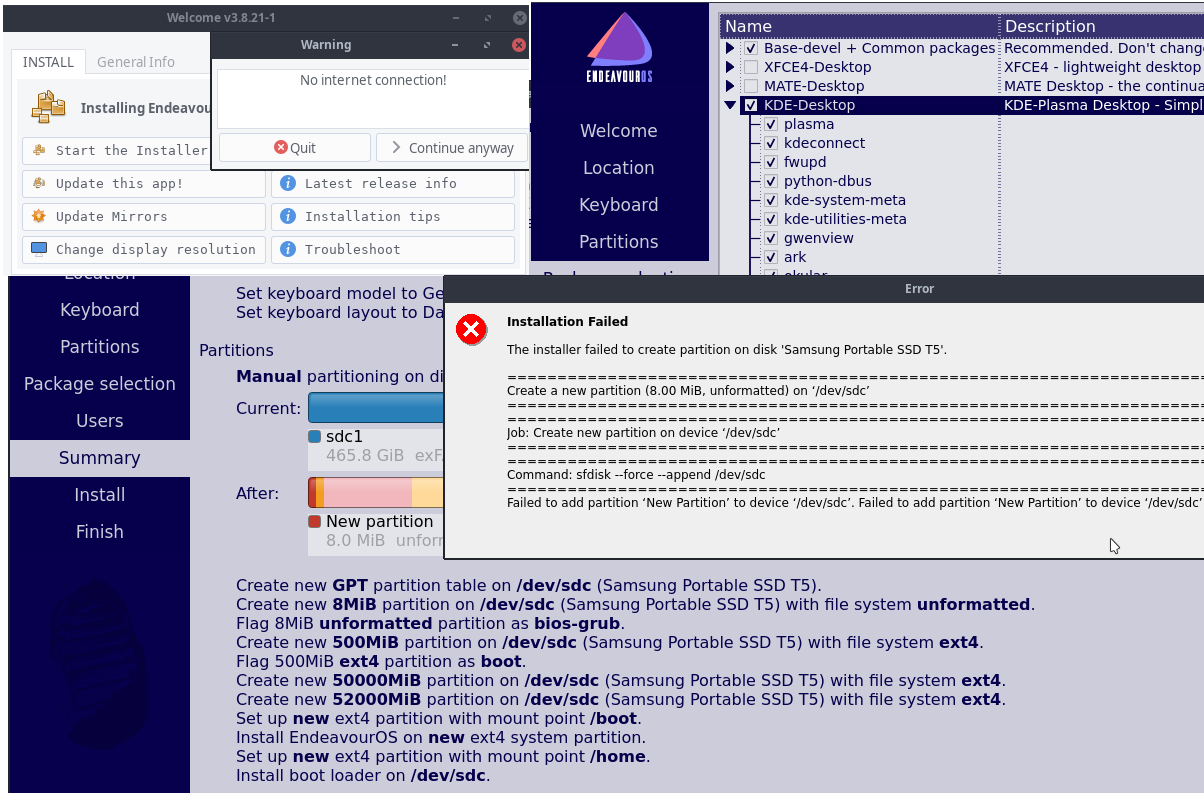did you check this ?
Magic? Here we are, at least 2 people who have an up and running working internet connection, but the installer still tells us that there are no connection. Then you find it’s magic that the installer later in the process, actually find the up and running working internet connection…
There seems to be something wrong with the installer and/or the ISO we used or something else.
It would be nice if it could be fixed
@FLVAL I also have
Realtek Semiconductor Co., Ltd. RTL8111/8168/8411 PCI Express Gigabit Ethernet Controller
The workaround says to reboot, which would not help much when running the installer from a live ISO.
That was never a problem when installing other Linux OSes
Instead of rebooting you could try to simply load the module after unblacklisting, e. g.
sudo modprobe r8169
This should work on the live ISO.
Sorry I meant the statement in a sarcastic/joking way. It literally means “how come installer says you are offline but able to install a plasma desktop for u when the installer package only has xfce in it?”
You get what I mean?
Just for the record for distros like Arch, Manjaro, Archman, RebornOS all auto configured my machine to r8169 and apparently never had any issues but I will try the workaround and come back to you asap.
Now I do. Thank you for making it more clear.
Won’t work for me.
Updated the app first.
The installer takes a long time before it finally says, that there are no connection.
I even downloaded a new ISO, checked the sha512, flashed it to USB drive, not using Ventoy.
Tested both wired and WiFi, same result either way.
Just for the record, on both wired and WiFi, the connection is working when surfing with Firefox.
From eos-log-tool.logs:
archiso NetworkManager[676]: [1610392434.5189] manager: NetworkManager state is now CONNECTED_GLOBAL
It works if I hit “Continue anyway”, but crash when partitioning. This might be because I’m installing it on an external drive.

Your partitioning setup looks odd. Why are you flagging an ext4 partition as boot?
Can you post the partitioning scheme you are trying to achieve?
That’s an error, should have been fat32.
I have a working install, after doing the partitioning before installing
But maybe i did that error before. I’ll test again.
Well, in my test I tested r8168 wouldn’t even connect to internet. Only works with r8169.
I tried to running installer again, same thing… however I clicked on Continue Anyway, guess what… the installer is downloading stuff in the background, well… using the internet. But it’s xfce stuff and I don’t want it. Well, just too unfortunate that I am running a messed up ethernet card and dev is not interested to make other iso then I’ll get on other distros. Cheers
Crashed again:
13:21:33 [6]: void Calamares::ViewManager::onInstallationFailed(const QString&, const QString&)
- details:
"Create a new partition (500.00 MiB, fat32) on ‘/dev/sdc’
Job: Create new partition on device ‘/dev/sdc’
Command: sfdisk --force --append /dev/sdc
Failed to add partition ‘New Partition’ to device ‘/dev/sdc’
Failed to add partition ‘New Partition’ to device ‘/dev/sdc’.\n\n"
Is this an UEFI install? If so did you mount that partition to /boot/efi and flag it boot? Unless you are trying something special why not just let the installer create the partitions for you?
No.
The special thing could be that the drive is a USB connected external SSD drive.
I used the installer as far as I know.
Choose the Manual partitioning when installing.
to make
/boot
/
/home
What’s the point of making such a beautiful and promoting so much features you provide when you don’t even bother fixing this issue. I may be the only one reporting it, could be many who remained quiet and installed something else.
Several people have been trying to help you already. The issue is most likely on your system, not on Endeavour’s side, or everyone would experience it. Would you like one of the devs to pop over to fix your attitude machine for you?
I suggest a mute.’… no place for that here!
Already done, found the ignore button. Didn’t plan on spending any more time arguing 
If you’ve tested it and it works with the r8169 i don’t see what the problem is. You are able to install then and remove the r8168 package and it will automatically load the r8169 module.
I know, the problem is even if I remove 8168 and remodprobed 8169 the internet became active again, only the installer couldn’t be able to detect it. (I tried before relaunching installer and tried again and nothing).
Seems like there’s some gang going here eh? Lol, boys acting cute.
I’m not being cute just explaining that it does work. Some hardware doesn’t like the r8168 and need the kernel module which is r8169 so as stated before requires the module to be removed or blacklist. Then once installed you can actually remove the r8168 module as it is a package that is installed.